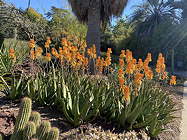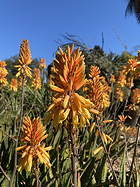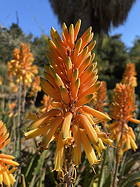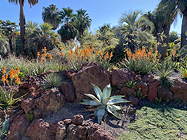In November, 2007, I visited the San Marino garden of Gwen Babcock, a dear friend and supporter of the Huntington’s Desert Collections. I was interested in checking on a succulent installation we had worked on a few years before. Many of the plants thrived on a south facing slope that received some dappled morning and afternoon shade. Not all of the plants performed as well as hoped, so Gwen made a few substitutions over the years. One addition was a clumping aloe with attractive, compact racemes of orange flowers. It appeared to be a form of Aloe camperi but with flowers in November. This represented a highly desirable extension of the flowering season for this species. We grow other forms that typically flower in April or, with the cultivar ‘May Day’, as late as the month of May! The plant did well in a container in our shade house, gradually increasing in size and beauty. Finally, in March of 2016, the plant had filled a 10" pot and was demanding more root room. We planted it at the bottom of the Desert Garden along the edge of the road that borders the west side of the Desert Garden and separates it from the Lily Ponds across the road. It thrived there and its cheery orange flowers were a nice complement to the orange fruits of the jelly palm, Butia capitata, that partly shades the bed. The plant proliferated over the next few years until we were able divide it and make a more impressive mass in this bed. When in flower, it never fails to impress with its tidy racemes and vivid color inspiring many who see it to photograph the scene. The rest of the year the low growing rosettes, only a foot or so tall, showed no tendency toward tip die-back or other blemishes, nor any sensitivity to the occasional frost experienced during winter in this part of the garden. Instead, it presents clean foliage with attractive white spotting and margins with prominent teeth that color up a glossy reddish-roan color. By 2023 the mass was becoming dense with offsetting clumps, affording the opportunity to divide and spread it around. The timing was convenient as we needed some showy material for the design of the new rockeries of volcanic scoria that we had just installed in the upper Desert Garden. We were delighted to find that not only did it flower spectacularly in November and December, as expected, but flowering persisted into the spring. The stemless, clumping rosettes suggested to visiting aloe expert Tom McCoy that this was a hybrid of A. camperi, perhaps with A. zubb, accounting for its repeat blooming. The cultivar name still stands and can serve to honor anyone named Gwen that you may be fond of. The plant has proven to be an ideal choice for small landscapes where it earns its keep with a long-lasting floral show and ease of care. Therefore, we initiated the plant into tissue culture to expedite this offering. Rooted plants of HBG 119912, $12.

Published in the Cactus and Succulent Journal, Vol. 97 (2), Summer 2025



